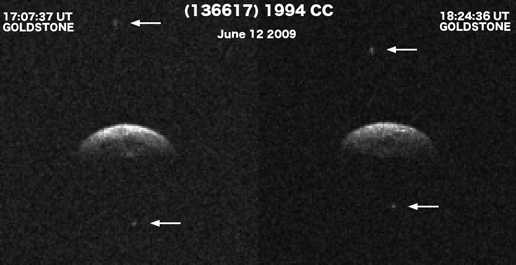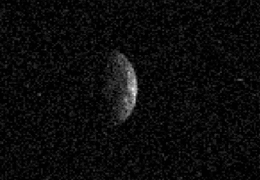(136617) 1994 CC
|
Flyby of asteroid 1994 CC in June 2009 with two moons. Image credit: NASA | |
| Discovery | |
|---|---|
| Discovered by | Spacewatch |
| Discovery date | February 3, 1994 |
| Designations | |
| none | |
| Apollo asteroid, Earth-crosser asteroid | |
| Orbital characteristics | |
| Epoch June 18, 2009 (JD 2455000.5)[1] | |
| Aphelion | 2.3234 AU |
| Perihelion | 0.9546 AU |
| 1.6390 AU | |
| Eccentricity | 0.4176 |
|
766.4179 d (2.10 a) | |
Average orbital speed | ? km/s |
| 350.3869° | |
| Inclination | 4.6841 |
| 268.6465° | |
| 24.7486° | |
| Physical characteristics | |
| Dimensions | 0.700 km |
| Mass | ?×10? kg |
Mean density | g/cm³ |
| ?×10-? m/s² | |
| ?×10-? km/s | |
| 2.3886 h | |
| Albedo | 1.637 |
| 17.8 | |
|
| |
(136617) 1994 CC is a near-Earth asteroid that was discovered on February 3, 1994, by Spacewatch's Jim Scotti.[2] In June 2009 it was shown to be a triple system, i.e. the largest body is orbited by two satellites; only about one percent (1%) of near-Earth asteroids observed by a radar are found to be triple systems such as this one.[3] The only other unambiguously identified triple asteroid in the near-Earth population is (153591) 2001 SN263, which was discovered to be a triple system in 2008.
Observations
A team of NASA's Jet Propulsion Laboratory (JPL) (Pasadena, California) scientists led by Marina Brozovic and Lance Benner, made the discovery using radar imaging at NASA's Goldstone Solar System Radar on June 12 and June 14, 2009. They showed that the near-Earth asteroid 1994 CC is a triple system, which encountered Earth within 2.52 million kilometers on June 10, 2009. This relatively close approach to Earth made the discovery possible, as before the approach, scientists knew very little about this asteroid. In fact, 1994 CC is only the second triple system known in the near-Earth objects population.[3]
1994 CC consists of a central object about 700 meters in diameter that has two moons revolving around it. Scientists' preliminary analysis of the system suggests that the moons are at least 50 meters in diameter. In a similar study, the radar observations at Arecibo Observatory in Puerto Rico, led by the Mike Nolan, also confirmed the detection of all three objects. The scientists plan to use the combined observations from the Goldstone and Arecibo observatories to study 1994 CC's orbital and physical properties further.[3]
The next similar Earth flyby for the asteroid 1994 CC will happen in 2074 when the triple system is projected to fly past Earth at a distance of 2.5 million kilometers.[3]

Orbital characteristics of satellites
The orbital properties of the satellites are listed in this table.[4] The orbital planes of both satellites are inclined relative to each other, by approximately 16°. Such a large inclination is suggestive of past evolutionary events (e.g. close encounter with a terrestrial planet, mean-motion resonance crossing) that may have excited their orbits from a coplanar configuration to an inclined state.
| Name | Mass [109 kg] | Semi-major axis [km] | Orbital period [days] | Eccentricity | Inclination (relative to asteroid) [°] |
|---|---|---|---|---|---|
| Beta (inner) | ~6 | 1.7 | 1.243 | 0.002 | 95 |
| Gamma (outer) | ~1 | 6.1 | 8.376 | 0.192 | 79 |
See also
- Near-Earth object
- List of notable asteroids
- 2004 FH
- 87 Sylvia
- 433 Eros
- 1990 SS
- (153591) 2001 SN263
References
- ↑ 136617 at the JPL Small-Body Database
- ↑ "Spacewatch Discoveries for 1994". Spacewatch NEO Detections by Year. University of Arizona. 22 August 2009.
Spacewatch Discoveries for 1994.
- ↑ 3.0 3.1 3.2 3.3 "Triple Asteroid System Triples Observers' Interest". NASA. 6 August 2009.
Radar imaging at NASA's Goldstone Solar System Radar on June 12 and 14, 2009, revealed that near-Earth asteroid 1994 CC is a triple system.
- ↑ Fang, Julia. "Orbits of Near-Earth Asteroid Triples 2001 SN263 and 1994 CC: Properties, Origin, and Evolution". Astronomical Journal. Retrieved 8 November 2012.
External links
- Official press release by NASA on triplet system
- (136617) 1994 CC compiled by Wm. Robert Johnston
- Julia Fang, "Orbits of Near-Earth Asteroid Triples 2001 SN263 and 1994 CC: Properties, Origin, and Evolution",
| ||||||
| ||||||||||||||||||||||||||||
